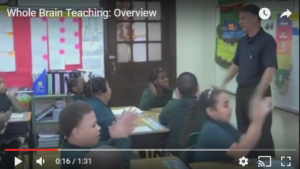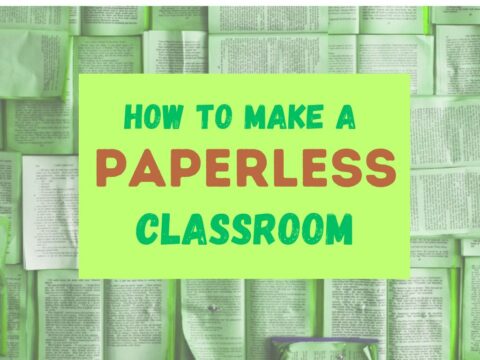 If you have challenging students in your classes, there’s a good chance someone has suggested that you look into Whole Brain Teaching (WBT). Whole Brain Teaching is an active teaching method designed to maximize student engagement in lessons, positive interactions with classmates, and educational fun. Instruction includes vocal directions mixed with hand gestures, inflections, full body movement, head motions, and chants. Studies show that this multi-sensory approach is how the brain is intended to learn and will result in a much greater probability of reaching teaching goals.
If you have challenging students in your classes, there’s a good chance someone has suggested that you look into Whole Brain Teaching (WBT). Whole Brain Teaching is an active teaching method designed to maximize student engagement in lessons, positive interactions with classmates, and educational fun. Instruction includes vocal directions mixed with hand gestures, inflections, full body movement, head motions, and chants. Studies show that this multi-sensory approach is how the brain is intended to learn and will result in a much greater probability of reaching teaching goals.
Where it might have originally been intended for challenging classes — much like Orton-Gillingham started as a multi-sensory learning system for dyslexics — WBT has matured into a strategy that works for lots of learners, even the quiet ones. It uses “model and repeat” as ways to join the right and left sides of the brain (such as the hippocampus, the prefrontal cortex, and the motor cortex) in student learning with the idea that if the entire brain is engaged in learning, there is nothing left over for misbehavior or distraction. For many K-12 teachers, WBT has become their primary teaching strategy.
WBT is based on four core components (called Core Four — part of a longer list of techniques):
Class-yes: Teachers focus the attention of students with just a few words. When the teacher says “Class”, students look at the teacher and answer “Yes”, redirecting their attention from wherever it was to the teacher.
Mirror: Teachers holds their hands up while speaking and students duplicate the words and hand movements. They get used to listening, following directions, keying in on what the teacher is doing, and fully engaging in the lesson. By using those parts of the brain that listen, talk, and respond, there’s little left to be distracted.
Teach OK: Students teach what they’ve just learned to each other.
Scoreboard Game: Students earn points for themselves (as a group) for doing stuff right and points for the teacher when they do stuff wrong. There is no judgment of an activity, merely one person winning on the scoreboard and another losing. The teacher or students who win get a pre-arranged prize. The Scoreboard Game improves classroom management and keeps students motivated as they experience success in this gamified environment.
Pros
WBT classes are fast-paced. Students don’t know when the Class-yes, Teach-OK, Mirror or Scoreboard Game activities will require them to engage actively so they constantly pay attention.
Because of the ongoing nature of the Scoreboard Game, students feel like everything they learn is part of a big game where they earn prizes.
When you enter a class, you’ll feel the energy and enthusiasm as students become active participants in instruction. You might even think they’re playing games and having fun at the expense of learning. They are having fun, and it’s building a love of learning.
In a study that sought to evaluate the impact of Whole Brain Teaching on the behaviors of challenging students, nine types of student behaviors were evaluated with fifth grade students. The results of this study indicated a 50% decrease in student negative behaviors from the pre-observations to the post-observations after implementing Whole Brain Teaching (Palasigue, 2009). These results support student engagement theories that state that the more a student is engaged in the lesson, the less likely the student will engage in disruptive behaviors (Scott, Hirn, & Alter, 2014).
Cons
If you watch a WBT video and don’t recognize the WBT strategy, you could confuse the parroting with old-school memorization. It’s not, but teachers must know how to make that differentiation for this approach to work in their classes. In truth, if WBT is not delivered correctly, it seems like it could become rote drills.
Again, when not delivered correctly, students can get caught up in the goofiness of the teaching method and forget the importance of what they are doing. Teacher training, personal attitude, and direction to students can fix this.
Students are encouraged to respond in preprogrammed phrases and words rather than independently-thinking out responses. The teacher must make it clear when responses are required and when higher-order thinking is what’s called for.
Shy students or those who are more reserved may be uncomfortable with so many hand and body gestures and the need to interact so often with classmates. Mostly this passes, but be aware of those students who have difficulty.
***
There are excellent training programs in Whole Brain Teaching (such as WholeBrainTeaching.com). Take advantage of these to get teachers excited about this effective, unique learning strategy. Don’t be afraid to unpack WBT slowly if you’d like, as students get used to it.
Here’s a video of WBT used in a class:
— featured image and video credit to Chris Biffle and WholeBrain Teaching
More about WBT:
EduKate Me (videos on WBT)
Whole Brain Teaching (videos)
Jacqui Murray has been teaching K-18 technology for 30 years. She is the editor/author of over a hundred tech ed resources including a K-12 technology curriculum, K-8 keyboard curriculum, K-8 Digital Citizenship curriculum. She is an adjunct professor in tech ed, Master Teacher, webmaster for four blogs, an Amazon Vine Voice, CSTA presentation reviewer, freelance journalist on tech ed topics, contributor to NEA Today, and author of the tech thrillers, To Hunt a Sub and Twenty-four Days. You can find her resources at Structured Learning.





































Thanks for sharing this article, this is really a good chance
192.168.1.1
Thanks!
FYI, for anyone interested in brain-based education, there’s a documentary that covers this topic quite well. While it’s told more from the human experience standpoint, it also covers most of the practical aspects of using brain-based teaching.. might be worth a look to some SDs for professional development credits. http://www.greymattersdocumentary.com/
Thanks for this, Lucas. It looks interesting.